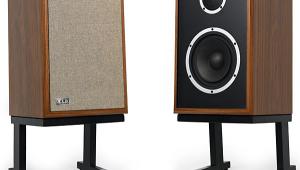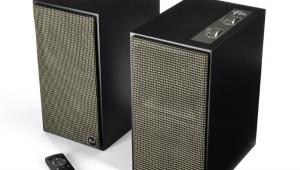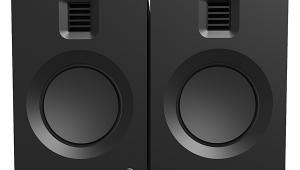Sunfire Cinema Ribbon CRM-2 Speaker System
What a long, strange trip it's been. I've reviewed hundreds of speakers—big towers, tiny satellites, high-end flagships, and a long run of budget models—but Sunfire's new XT Series Cinema Ribbon speaker is something different. I couldn't get over how this little thing, standing just 8.25 inches tall, can play bloody loud and project the sort of huge and still highly focused imaging I've only heard from exotic, big-bucks speakers. On well-recorded concert DVDs, like Pixies: Live at the Paradise in Boston, the Cinema Ribbons let me hear around each musician. It was as if the band had materialized, fully formed, in front of me. If I had any doubts about the pint-sized speakers' ability to handle gobs of power, rocking out with the Led Zeppelin two-disc DVD set convinced me. John Bonham's hand drumming on "Moby Dick" had the sort of tactile, palpable presence you hear in real life. With the volume cranked, I felt—and I mean felt—each whack on the floor toms. The Cinema Ribbons (with the assistance of Sunfire's True Subwoofer EQ) sounded like a set of tower speakers.
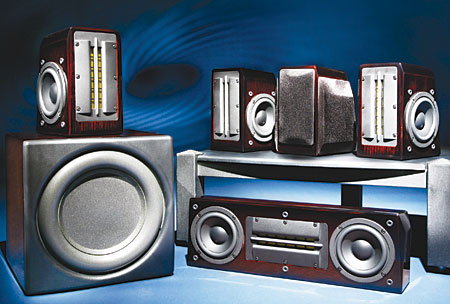
How Does It Do That?
A 6-inch planar magnetic tweeter completely covers the Cinema Ribbon CRM-2's front baffle. The tweeter is essentially a lightweight diaphragm with an etched aluminum-foil conductor that is suspended between neodymium magnets. Look closely, and you'll see that the diaphragm isn't a single metal ribbon (the strict definition of a ribbon driver)—it's in fact a very skinny, 5-foot-long conductive strip wrapped around and around. Its ultralow moving mass allows the diaphragm to reproduce treble detail with a claimed ultrahigh-frequency response up to 40 kilohertz—and with what I personally find to be a realism no dome tweeter can match. Each side of the speaker is fitted with an all-new 4.5-inch driver that has two unusual design features: an oversized, four-layer copper voice coil and a suspension that allows for a 1-inch peak-to-peak, back-and-forth excursion. (That's more typical of larger drivers.) Sunfire designed the cabinet's purposeful shape to enhance the sound—the sides are parallel, but the top panel slopes back to meet the rakishly canted rear baffle. The tweeter is responsible for the speaker's pinpoint imaging, while the side-mounted woofers project a spectacularly wide soundstage. You've never heard anything quite like the CRM-2.
You can use the speakers with just about any receiver, even a moderately powered model, or with monstrous amps, including Sunfire's TGA-7400 400-watt-per-channel power amp.
The Cinema Ribbon CRM-2C center speaker uses the very same drivers as the CRM-2, but the two woofers straddle the tweeter on the front baffle, which is positioned horizontally instead of vertically. In an attempt to correct for the limited horizontal dispersion that can often result from this driver array, Sunfire molded an acoustic lens into the grille frame. Male and female voices sounded lifelike and immediate, without any of the closed-in, boxy midrange quality I hear from so many small center speakers.
You can match the Cinema Ribbons with any of Sunfire's eight subwoofer models, ranging from the $649 D-8 8-inch sub to the $2,195 True Subwoofer EQ Signature 12-inch model. I used their True Subwoofer EQ, which is pretty amazing in its own right. Its claimed 2,700-watt amplifier drives one burly-looking 10-inch woofer, and a matching 10-inch passive radiator is on the other side of the cabinet. The cube-shaped sub also features a built-in, four-band equalizer to help smooth out any nasty room anomalies that could color the bass. The True Subwoofer EQ's microphone and auto-EQ tuning system work well enough, but I preferred to manually tune the True's EQ by ear. Deep, deep bass was rock solid, so the little guy rattled my room with a vengeance. Still, even after a lot of tweaking, the sub's bass did not seamlessly gel with the Cinema Ribbons. The audible bass gap between the sub and the satellites made some CDs and DVDs sound thinner than they ought to, and bass definition was good but not great. (See the HT Labs box for details.)
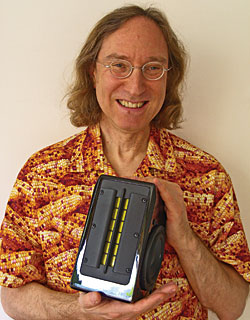 The Cinema Ribbons and True Subwoofer EQ are finished with seven coats of high-gloss ebonized lacquer over rosewood. In all but the brightest light, the Sunfires' finish appears black.
The Cinema Ribbons and True Subwoofer EQ are finished with seven coats of high-gloss ebonized lacquer over rosewood. In all but the brightest light, the Sunfires' finish appears black.
The speakers' tonal balance mellowed over the first 100 hours, and the speakers developed a presence that belied their size. I used OmniMount's SAT2 floor stands with the Cinema Ribbons, and the combination not only looked smart, it positioned the speakers for the best possible sound. Wall mounting is also possible; if you choose that route, flick the speakers' boundary-compensation switch from Room to Wall to reduce the bass bulge that can occur when the speakers are wall mounted. I noticed that the exact angle of the speakers' toe-in alters the treble brightness. (As you aim the speakers in, toward the sweet spot, the sound is brighter than it is when they fire straight ahead.) And I couldn't help but notice that, when I stood up, the treble response and detail dropped like a stone. On the positive side, the Cinema Ribbons' limited vertical dispersion minimizes image-degrading floor and ceiling reflections. That also meant, for me at least, that the surround speakers sounded their best mounted on floor stands at the same height as the front speakers. Alternatively, you could position the surround speakers higher up on the wall; just remember to aim them down toward the listener. I also noticed that the CRM-2C center speaker didn't sound as open as the CRM-2. So, I experimented with using a CRM-2 in the center position, and I preferred that setup. What can I say? An identical speaker array all around really does sound better.
Expanding Sonic Boundaries
The Cinema Ribbons came alive when I played Variations, a recent Stereophile CD of pianist Robert Silverman performing Beethoven's Diabelli Variations. The recording presented the tickled Steinway's rich harmonics masterfully, and I loved the way the Cinema Ribbons decoded Silverman's touch. With my eyes closed, I felt like I was in a concert hall. The illusion was that perfect. And, when I used my Sunfire Theater Grand III pre/pro's Sonic Holography processor (a feature found on every Sunfire pre/pro), the perception of soundstage depth in my stereo recordings doubled.
The Cinema Ribbons' ability to unravel even the most densely packed recordings made them sound less like hi-fi and more like real life. My favorite heavy-metal percussion band, Savage Aural Hotbed, has a new CD, The Unified Pounding Theory, wherein they whack the bejesus out of metal drums, beer kegs, springs, pipes, mufflers, and occasional instruments. The tunes balance a furious tribal energy with softer, more mesmerizing rhythms to create a cohesive and surprising musical whole. The Cinema Ribbons' extraordinary clarity gave the music an immediate quality that few speakers of any size can match.
Yes, when I played big, special-effects-heavy flicks like Superman Returns at high volume, the Cinema Ribbons' trim dimensions were more sonically obvious. The scene where Superman guides a passenger jet to a safe landing was plenty exciting, but the speakers didn't deliver the sonic throw weight I'd get from large bookshelf or floorstanding speakers. Still, the Cinema Ribbons sure did better in this regard than any minispeaker I can think of. As reviewed, this speaker system retails for $5,650 and delivers a nearly perfect amalgam of audiophile and home theater performance traits in a small size. It really is amazing.
Highlights
• The Cinema Ribbon speakers not only sound amazing, these 8-inch-tall speakers can rock the house almost like some tower speakers
• Holographic, utterly three-dimensional imaging and soundstaging


